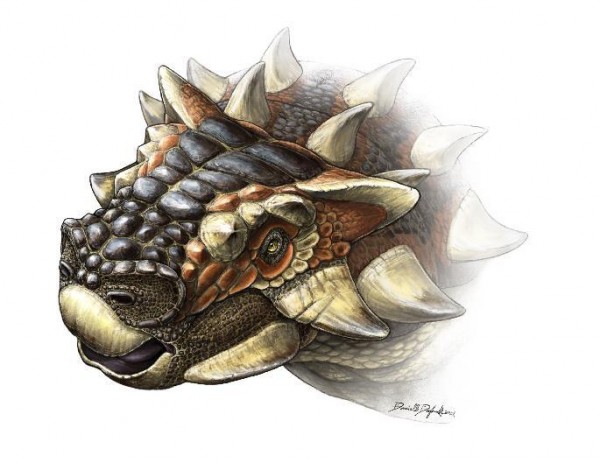Newly Discovered Mongolian Ankylosaur is Ugly but Sexy
| Marc Maligalig | | Oct 30, 2014 02:31 AM EDT |
(Photo : Danielle Dufault) An artist's representation of Zaraapelta nomadis
The discovery of the dinosaur, Zaaraapelta nomadis, a new family member of the ankylosaur species suggests the Gobi Desert had one of the largest number of the dinosaurs that lived together at the same time, second only to the badlands of southern Alberta, Canada.
The new species was discovered by Phil Currie in the year 2000. The name Zaraapelta is a portmanteau of Greek and Mongolian words for "shield" and "hedgehog" and refers to the ankylosaur's spiky features.
Like Us on Facebook
The word "nomadis" is in honor of the Nomadic Expeditions, a Mongolian company that has facilitated the paleontological fieldwork in the Gobi Desert for almost over 20 years.
The dinosaur is known from a well-preserved skull, which is missing a front of its snout. The top of its skull is spiky and bumpy, similar to the heads of other types of ankylosaurs from the Gobi Desert.
With an elaborate pattern of grooves and bumps around its eyes, Zaraapelts is even more extravagant than other Mongolian species of ankylosaurs.
The skull, which is part of the collection of the Mongolian Paleontological Center in Ulaanbaatar, has distinctive horns on its back and a big ridge along its top.
The distinctive and elaborate ornamentation on the skulls of Zaraapelta, and other members of its species, Saichania and Tarchia, may have been evolved to be able to showcase themselves to the members of the opposite sex, believes Victoria Arbour who led a team of paleontologists that discovered Zaaraapelta nomadis.
Scientists long believed other species of dinosaurs such as the crested hadrosaurs and ceratopsians equipped with frills and horns the ornaments in sexual displays. The concept, however, has not been applied to ankylosaurs yet.
"You can think of bone as being an expensive item for your body to maintain," she explained. "Bone requires a lot of nutrients and metabolic energy to create, and so that investment needs to pay off in some way."
She added that the ankylosaurs may have had the ornamentation for defensive purposes. Another viable explanation is the bumps and horns on the skulls demonstrated they have superior genes, similar to the message transmitted by male peacocks using their tail feathers.
TagsMongolia, Mongolian dinosaur, Ankylosaur, Gobi Desert, Zaraapelta nomadis, Phil Currie, Victoria Arbour
©2015 Chinatopix All rights reserved. Do not reproduce without permission
EDITOR'S PICKS
-

Did the Trump administration just announce plans for a trade war with ‘hostile’ China and Russia?
-

US Senate passes Taiwan travel bill slammed by China
-

As Yan Sihong’s family grieves, here are other Chinese students who went missing abroad. Some have never been found
-

Beijing blasts Western critics who ‘smear China’ with the term sharp power
-

China Envoy Seeks to Defuse Tensions With U.S. as a Trade War Brews
-

Singapore's Deputy PM Provides Bitcoin Vote of Confidence Amid China's Blanket Bans
-

China warns investors over risks in overseas virtual currency trading
-

Chinese government most trustworthy: survey
-

Kashima Antlers On Course For Back-To-Back Titles
MOST POPULAR
LATEST NEWS
Zhou Yongkang: China's Former Security Chief Sentenced to Life in Prison

China's former Chief of the Ministry of Public Security, Zhou Yongkang, has been given a life sentence after he was found guilty of abusing his office, bribery and deliberately ... Full Article
TRENDING STORY

China Pork Prices Expected to Stabilize As The Supplies Recover

Elephone P9000 Smartphone is now on Sale on Amazon India

There's a Big Chance Cliffhangers Won't Still Be Resolved When Grey's Anatomy Season 13 Returns

Supreme Court Ruled on Samsung vs Apple Dispute for Patent Infringement

Microsoft Surface Pro 5 Rumors and Release Date: What is the Latest?











